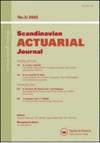潜在矩阵的遗传和混合模型对非负风险的正仿射预测
IF 1.4
3区 经济学
Q3 MATHEMATICS, INTERDISCIPLINARY APPLICATIONS
引用次数: 0
摘要
对非负风险变量的非负线性滤波要求随机效应的方差-协方差矩阵具有正性,如果经验评级是由混合模型导出的。一个方差协方差矩阵是一个势阵,如果它是非奇异的,如果它的逆是对角占优的,并且非对角项都是非正的。我们考虑具有平稳随机效应的风险模型,其方差-协方差矩阵为势。从这些混合模型中获得了非负风险的正可信度预测因子。在提取主子矩阵的条件下,封闭了作为势的方差-协方差矩阵集。如果视界大于1且历史是空白的,这种强烈的遗传特性保持了仿射预测因子的正性。本文提出的动态随机效应的规范满足了混合分布中存储器长度的三个可能层次的正性要求。一个案例研究讨论了从动态随机效应中预测纯溢价的可能策略。本文章由计算机程序翻译,如有差异,请以英文原文为准。
Hereditarity of potential matrices and positive affine prediction of nonnegative risks from mixture models
ABSTRACT Nonnegative linear filtering of nonnegative risk variables necessitates positivity properties on the variance–covariance matrices of random effects, if experience rating is derived from mixture models. A variance–covariance matrix is a potential if it is nonsingular and if its inverse is diagonally dominant, with off-diagonal entries that are all nonpositive. We consider risk models with stationary random effects whose variance–covariance matrices are potentials. Positive credibility predictors of nonnegative risks are obtained from these mixture models. The set of variance–covariance matrices that are potentials is closed under extraction of principal submatrices. This strong hereditary property maintains the positivity of the affine predictor if the horizon is greater than one and if the history is lacunary. The specifications of the dynamic random effects presented in this paper fulfill the required positivity properties, and encompass the three possible levels for the length of memory in the mixing distribution. A case study discusses the possible strategies in the prediction of the pure premium from dynamic random effects.
求助全文
通过发布文献求助,成功后即可免费获取论文全文。
去求助
来源期刊

Scandinavian Actuarial Journal
MATHEMATICS, INTERDISCIPLINARY APPLICATIONS-STATISTICS & PROBABILITY
CiteScore
3.30
自引率
11.10%
发文量
38
审稿时长
>12 weeks
期刊介绍:
Scandinavian Actuarial Journal is a journal for actuarial sciences that deals, in theory and application, with mathematical methods for insurance and related matters.
The bounds of actuarial mathematics are determined by the area of application rather than by uniformity of methods and techniques. Therefore, a paper of interest to Scandinavian Actuarial Journal may have its theoretical basis in probability theory, statistics, operations research, numerical analysis, computer science, demography, mathematical economics, or any other area of applied mathematics; the main criterion is that the paper should be of specific relevance to actuarial applications.
 求助内容:
求助内容: 应助结果提醒方式:
应助结果提醒方式:


